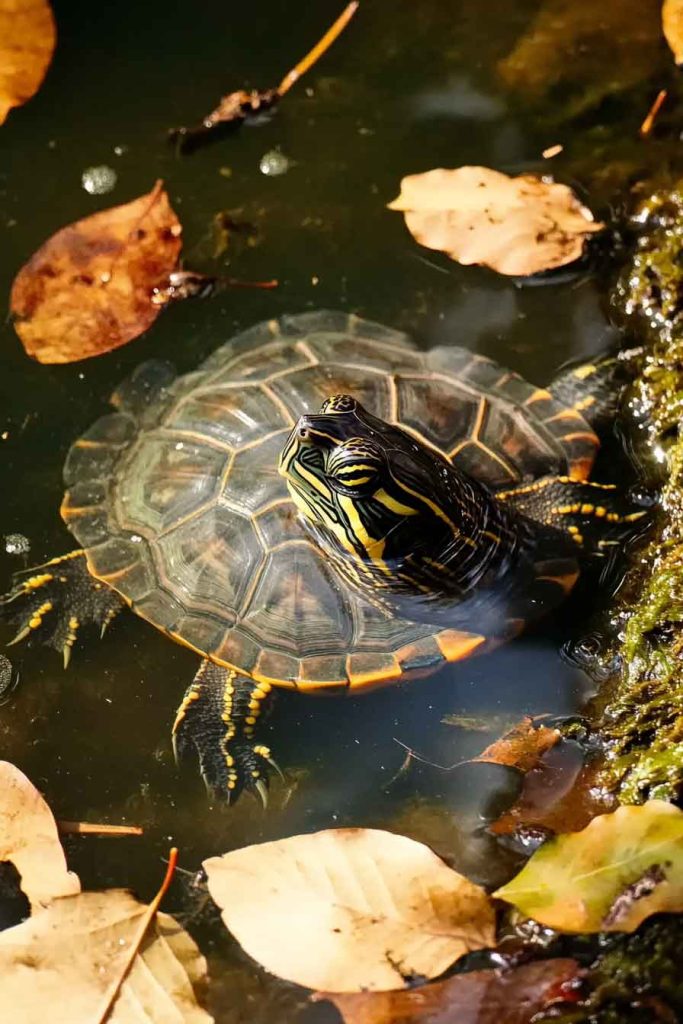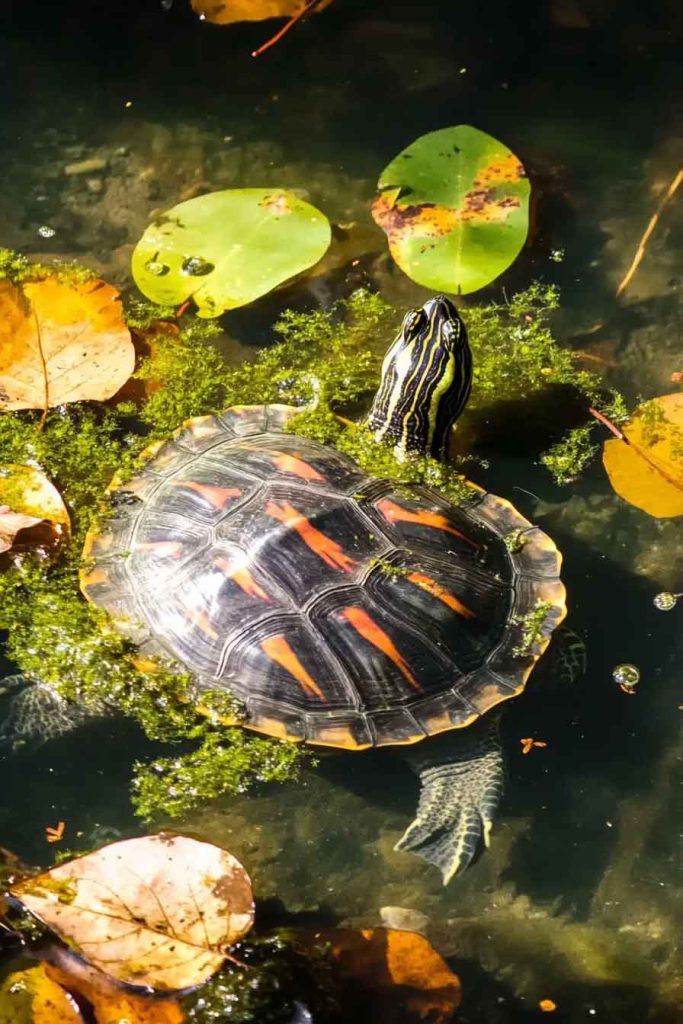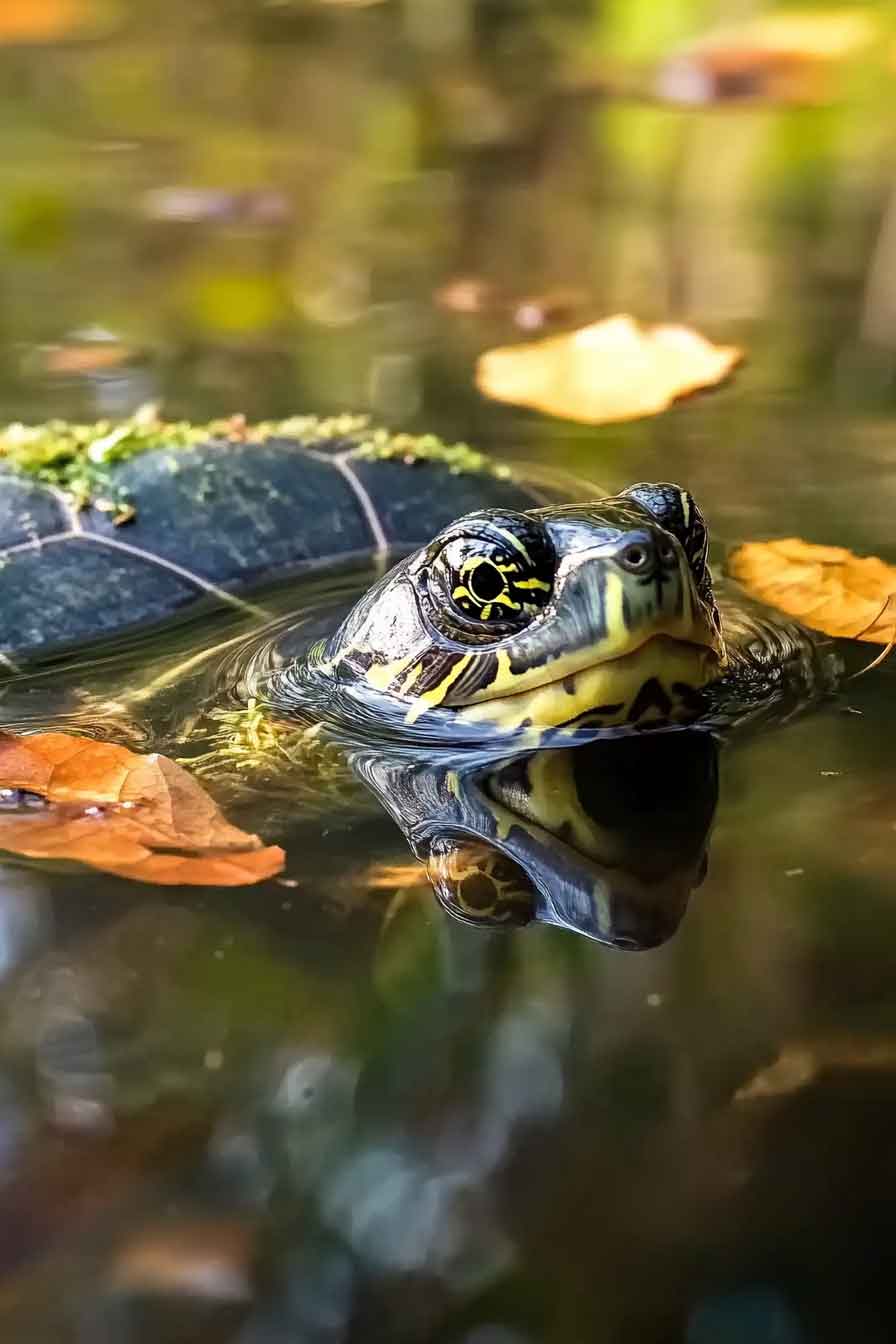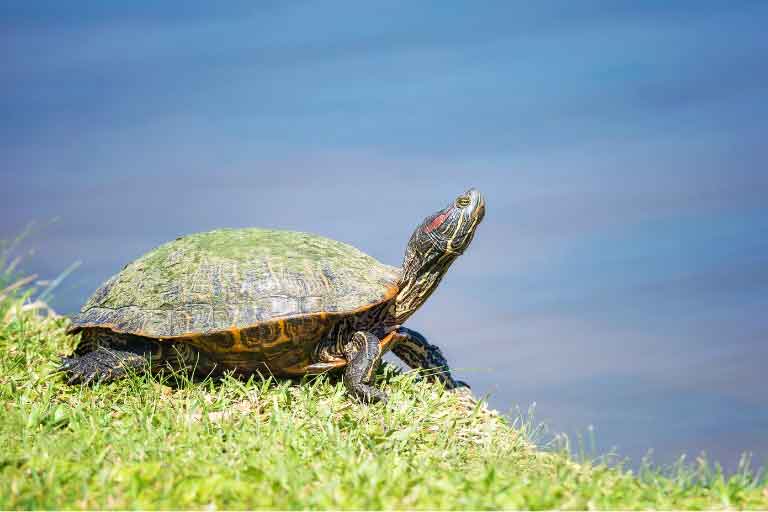How Long Can Aquatic Turtles Stay Out of Water? Full Care and Safety Guide
Hey there, turtle lover! If you’re like me, you’ve probably watched your aquatic turtle friend climb onto their basking platform and wondered, “How long can they actually stay up there?” I remember the first time I got my red-eared slider, I was constantly worried about whether she was spending too much time out of the…
Hey there, turtle lover! If you’re like me, you’ve probably watched your aquatic turtle friend climb onto their basking platform and wondered, “How long can they actually stay up there?” I remember the first time I got my red-eared slider, I was constantly worried about whether she was spending too much time out of the water or not enough. Let me share everything I’ve learned about this topic through my years of keeping aquatic turtles.
Quick Answer: The 8-Hour Rule
Here’s what I’ve discovered: aquatic turtles can typically stay out of water for about 8 hours without any problems. But here’s the thing – it’s not quite that simple. The exact time depends on several factors like your turtle’s age, the temperature around them, and what time of year it is. During brumation (that’s turtle hibernation), they can actually stay out for months!
I know that might sound confusing, so let me break it all down for you in detail.
Understanding Your Turtle’s Relationship with Water
Before we dive into the specifics, I want you to understand something important: water isn’t just a nice-to-have for aquatic turtles – it’s essential to their survival. Think of it like this: water is to your turtle what air is to us. They can survive without it for a while, but they need it to thrive.
In my experience, aquatic turtles will naturally come out of the water on their own for specific reasons. I’ve watched my turtles do this countless times, and it’s completely normal behavior.
How Long Can Different Aquatic Turtles Stay Out of Water?
Let me get specific here because not all aquatic turtles are the same.
Adult Aquatic Turtles
For most adult aquatic turtles, I’ve found they can comfortably stay out of water for 6 to 8 hours. I’ve seen my own turtles bask for 4-5 hours at a time without any issues. They know their limits better than we do!

Baby Aquatic Turtles
Now, baby turtles are a different story. When I had hatchlings, I noticed they couldn’t stay out nearly as long as the adults. Baby turtles should only be out of water for 1-2 hours maximum. Their little bodies just don’t have the energy reserves that adults have, and they dehydrate much faster.
Semi-Aquatic Species
If you have a red-eared slider, painted turtle, or map turtle like I do, these semi-aquatic species are pretty hardy. They can handle being out of water better than fully aquatic species. I’ve observed them staying out for up to 8 hours comfortably.
Fully Aquatic Species
Softshell turtles and some other fully aquatic species? They prefer to stay in the water most of the time. I rarely see them out for more than an hour or two for basking.
What Factors Affect How Long Your Turtle Can Stay Out?
Through my years of turtle keeping, I’ve identified several key factors that determine how long your turtle can safely stay on land. Let me walk you through each one.
1. Age and Size of Your Turtle
I can’t stress this enough – age matters tremendously!
Hatchlings and juveniles need water more frequently. When I raised baby turtles, I made sure they had easy access back to water at all times. Their bodies are still developing, and they don’t have the fat reserves or moisture retention abilities of adults.
Adult turtles have fully developed bodies with better moisture retention. I’ve noticed my older turtles can handle longer basking sessions without any problems.
2. Temperature and Humidity
This is huge! The environment makes all the difference.
Hot, dry conditions: In summer, I’ve noticed my turtles don’t stay out as long. The heat dehydrates them faster. If it’s over 85°F and humidity is low, your turtle should only be out for 3-4 hours maximum.
Cool, humid conditions: On cooler days with high humidity (above 60%), I’ve seen my turtles comfortably stay out for the full 8 hours or even longer. The moisture in the air helps keep them hydrated.
Cold temperatures: When it gets cold (below 50°F), turtles naturally slow down. Their metabolism drops, and they can survive much longer without water. This brings me to brumation.
3. Brumation (Hibernation)
This one amazed me when I first learned about it. During winter brumation, aquatic turtles can stay out of water for 3 to 7 months!
Now, I keep my turtles indoors with proper heating, so they don’t brumate. But wild turtles and outdoor turtles will naturally brumate when temperatures drop below 50°F. During this time, their metabolism slows to almost nothing, and they barely need any water at all.
I don’t recommend forcing brumation unless you’re experienced. It can be risky if not done correctly.
4. Health Condition
A healthy turtle can stay out longer than a sick one. I learned this the hard way when one of my turtles developed a respiratory infection. She couldn’t regulate her body temperature well and needed to stay in water more often.
5. Species-Specific Needs
Different species have different needs:
- Red-eared sliders: 6-8 hours
- Painted turtles: 6-8 hours
- Map turtles: 5-7 hours
- Softshell turtles: 1-3 hours (they really love water!)
- Musk turtles: 4-6 hours
Why Do Aquatic Turtles Come Out of Water?
I’ve observed my turtles coming out of water for several important reasons. Understanding these will help you provide better care.
Basking for Warmth and UV Light
This is the main reason! Aquatic turtles are ectothermic (cold-blooded), meaning they can’t generate their own body heat. I’ve watched my turtles climb onto their basking platform almost like clockwork every morning.
Basking serves multiple purposes:
- Temperature regulation: They need to warm up to digest food properly
- UV exposure: UVB light helps them produce vitamin D3, which is essential for calcium absorption
- Drying off: This prevents shell rot and fungal infections
I make sure my turtles have a basking spot that reaches 85-95°F with a good UVB bulb. This setup has kept them healthy for years.
Breathing
While turtles can hold their breath for a long time underwater, they still need to breathe air regularly. I’ve noticed my turtles surface frequently to take breaths. Coming onto land gives them unlimited access to air.
Egg Laying (Females)
If you have a female turtle, she’ll need to come out of water to lay eggs. I remember the first time my female started digging – I was so worried! But it’s completely natural. Female turtles will dig nests on land to lay their eggs, even if the eggs aren’t fertilized.
Exploration and Exercise
Sometimes turtles just want to walk around! I’ve caught my turtles exploring their enclosure, climbing on decorations, and just generally being curious. It’s enrichment for them, like how we might go for a walk.
Why Does Water Matter So Much to Aquatic Turtles?
Let me explain why your turtle can’t just become a land turtle, even if they could physically survive on land.

Hydration and Moisture
Aquatic turtles absorb water through their skin and cloaca. I’ve learned that they need to be submerged regularly to maintain proper hydration levels. Without enough water time, they’ll become dehydrated, which leads to serious health problems.
Eating and Digestion
Here’s something that surprised me: aquatic turtles can only eat in water! They don’t produce saliva, so they need water to moisten and swallow their food. I always feed my turtles in the water, and they gulp down water with each bite.
Water also helps them digest food. The moisture aids in breaking down food and moving it through their digestive system.
Temperature Regulation
Water helps turtles cool down when they’re too hot. On summer days, I’ve watched my turtles alternate between basking and swimming to regulate their body temperature perfectly.
Shell and Skin Health
Being in water keeps their shell and skin healthy. The water provides moisture that prevents their skin from drying out and cracking. However, they also need time out of water to dry off and prevent shell rot – it’s all about balance!
Swimming and Exercise
Turtles are natural swimmers, and they need that exercise to stay healthy. Swimming works their muscles, keeps their cardiovascular system strong, and provides mental stimulation. I’ve noticed my turtles are much happier when they have plenty of swimming space.
Warning Signs Your Turtle Has Been Out Too Long
Through experience, I’ve learned to recognize when a turtle has been out of water for too long. Here’s what to watch for:
Dehydration Symptoms
- Sunken eyes: This is one of the first signs I look for
- Wrinkled skin: The skin looks loose and dry
- Lethargy: Your turtle seems weak or unresponsive
- Dry mouth: The inside of their mouth looks pale and dry
If you see these signs, get your turtle back in water immediately!
Overheating Signs
- Rapid breathing: Breathing with their mouth open
- Excessive basking attempts: They keep trying to bask but seem uncomfortable
- Restlessness: They can’t seem to settle down
Stress Behaviors
- Trying desperately to get back to water: Scratching at tank walls or climbing
- Hiding: Attempting to burrow or hide
- Loss of appetite: Not interested in food
Common Problems: Why Your Turtle Might Stay Out Too Long
Let me share some issues I’ve encountered and helped other turtle owners solve.
Problem 1: Water Temperature Issues
Too cold: If your water is below 75°F, your turtle might avoid it. I use an aquarium heater to keep my water between 75-80°F for my turtles.
Too hot: Water above 85°F is uncomfortable too. I had to add a cooling fan one summer when my tank got too warm.
Problem 2: Poor Water Quality
I can’t emphasize this enough: dirty water will drive your turtle out! Turtles are messy, and if you don’t keep up with water changes, the ammonia and nitrite levels will make the water toxic.
My solution:
- Weekly 25% water changes
- A powerful filter rated for twice your tank size
- Regular testing with an aquarium test kit
Problem 3: Bullying from Tank Mates
I learned this the hard way when I tried housing two males together. One turtle dominated the water, forcing the other to stay on land constantly. If you notice this:
- Separate aggressive turtles
- Provide multiple basking areas
- Ensure your tank is large enough (10 gallons per inch of shell length per turtle)
Problem 4: Inadequate Basking Area
If your turtle is staying out too long, check if your basking area is:
- Easy to climb onto
- Completely dry
- Large enough for all turtles
- At the right temperature (85-95°F)
I upgraded my basking platform, and it made a huge difference!
Problem 5: Medical Issues
Sometimes turtles stay out of water due to health problems:
- Respiratory infections: They need easier breathing access
- Shell rot: Water might irritate infected areas
- Parasites: Discomfort drives them out
If you suspect illness, consult a reptile veterinarian.
When Your Turtle Won’t Come Out of Water
On the flip side, I’ve also dealt with turtles that refuse to come out! Here’s what might be happening:
It’s Just Their Personality
Some turtles are water lovers! Softshell turtles, for example, rarely bask. If your turtle is eating well, seems healthy, and occasionally comes up for air, they might just prefer swimming.
The Basking Area Isn’t Appealing
Check if:
- The basking platform is too small
- It’s too difficult to climb
- The temperature isn’t warm enough
- There’s no UVB light
I once had a turtle who wouldn’t bask until I repositioned the heat lamp. Simple fix, big difference!
Temperature Issues
If your water is too warm, your turtle might think it’s summer and stay active underwater. If it’s too cold, they might enter a state similar to brumation and stay at the bottom.
Keep water at 75-80°F and basking area at 85-95°F.
They’re Not Feeling Well
A turtle that suddenly stops basking might be sick. Watch for:
- Loss of appetite
- Floating problems
- Breathing issues
- Lethargy
When in doubt, see a vet!
How Much Water Do Aquatic Turtles Actually Need?
Here’s my rule of thumb: 10 gallons of water per inch of shell length.
Let me give you some examples from my own experience:
- 4-inch turtle: Needs at least a 40-gallon tank
- 6-inch turtle: Needs at least a 60-gallon tank
- 8-inch turtle: Needs at least an 80-gallon tank
Water Depth Matters Too
I keep my water deep enough for my turtles to swim comfortably – at least 1.5 to 2 times their shell length. My red-eared slider loves diving and swimming, so I give her plenty of depth.
Multiple Turtles
If you have more than one turtle, multiply accordingly. Two 5-inch turtles need at least 100 gallons of water!
My Best Practices for Healthy Water-Land Balance
Let me share what works for me after years of trial and error:
1. Create an Ideal Environment
- Basking area: 85-95°F with UVB lighting
- Water temperature: 75-80°F
- Air temperature: 75-80°F
- UVB light: 10-12 hours daily
- Water depth: 2x shell length minimum
2. Monitor Your Turtle’s Behavior
I spend time watching my turtles daily. I’ve learned their normal patterns:
- How long they typically bask (3-4 hours for mine)
- When they prefer to eat (morning)
- Their activity levels throughout the day
Any changes alert me to potential problems.
3. Maintain Excellent Water Quality
This is non-negotiable! My routine:
- 25% water change weekly
- Filter maintenance monthly
- Water testing weekly (ammonia, nitrite, nitrate, pH)
- Spot cleaning daily
4. Provide Proper Nutrition
A well-fed turtle is a healthy turtle. I feed mine:
- Commercial turtle pellets (staple diet)
- Fresh vegetables (collard greens, dandelion greens)
- Occasional protein (fish, shrimp, insects)
- Calcium supplements with vitamin D3
5. Regular Health Checks
Every week, I examine my turtles for:
- Shell abnormalities
- Eye clarity
- Skin condition
- Energy levels
- Appetite changes
Special Considerations for Different Situations
Taking Your Turtle Out for Handling
Sometimes you’ll need to remove your turtle from their tank for cleaning or vet visits. Here’s what I do:
- Keep it brief: 15-30 minutes maximum
- Keep them damp: Mist with water or place on a damp towel
- Avoid extreme temperatures: Don’t take them outside in very hot or cold weather
Transporting Your Turtle
When I need to transport my turtles:
- I use a secure container with damp towels
- No standing water (they could drown if the container tips)
- Keep transport time under 3-4 hours
- Provide water immediately upon arrival
Outdoor Time
I sometimes let my turtles enjoy supervised outdoor time in warm weather:
- Only when temperature is 75-85°F
- Always supervised (predators are a real threat!)
- Provide shade and water access
- Never leave them on concrete or hot surfaces
- Limit to 2-3 hours maximum
What Happens If a Turtle Stays Out Too Long?
I want to be honest about the risks because prevention is always better than treatment.
Short-Term Effects
After 12-24 hours out of water:
- Dehydration begins
- Stress hormones increase
- Digestion slows or stops
- Energy levels drop
Long-Term Consequences
Extended periods (days) without water can cause:
- Severe dehydration: Can be fatal
- Organ damage: Kidney problems are common
- Shell problems: Pyramiding and shell deformities
- Metabolic issues: Their whole system can shut down
I once helped a friend whose turtle was accidentally left out for two days. It took weeks of intensive care from a vet to save him. Don’t let this happen!
Frequently Asked Questions
Can aquatic turtles live on land permanently?
No! I’ve seen people try this, and it always ends badly. Aquatic turtles are not adapted for land life. They need water to eat, stay hydrated, and regulate their body temperature. Keeping them on land permanently will kill them.
How often should my turtle bask?
Most healthy aquatic turtles will bask for 3-5 hours daily. Mine have their own schedules – one basks in the morning, the other prefers afternoon. As long as they’re basking regularly and you have proper UVB lighting, they’re fine.
My turtle hasn’t come out to bask in days – is this normal?
It might be normal for some species (like softshells), but for most aquatic turtles, not basking for several days is concerning. Check your setup and consider a vet visit if it continues.
Can I force my turtle to stay in or out of water?
Please don’t! Turtles know what they need. Your job is to provide the right environment, and they’ll naturally balance their time. Forcing them causes stress and health problems.
What if I need to be away from home?
For trips up to 3 days, an adult turtle will be fine with automatic feeders and proper setup. Longer than that, arrange for someone to check on them. I have a trusted friend who watches mine when I travel.
My Final Thoughts
After keeping aquatic turtles for years, here’s what I want you to remember: your turtle is the best judge of what they need. Your job is to create an environment where they can make those choices naturally.
Provide:
- Clean, warm water they want to swim in
- A comfortable basking area they want to use
- Proper lighting that mimics natural conditions
- Good nutrition to keep them strong
When you get these fundamentals right, your turtle will naturally balance their time between water and land. They’ll be out for about 6-8 hours daily for basking and come back to water when they need to.
I’ve learned that turtle keeping isn’t about strict rules – it’s about observation, adjustment, and providing the best care possible. Watch your turtle, learn their patterns, and respond to their needs.
If you’re ever unsure whether your turtle has been out too long or not enough, err on the side of caution and consult a reptile veterinarian. These beautiful creatures depend on us to understand their needs and keep them healthy.
Remember: a happy turtle is one that has the choice to swim, bask, eat, and explore on their own schedule. Give them that freedom within a safe, properly maintained environment, and you’ll have a healthy companion for decades to come.
Do you have questions about your turtle’s behavior? I’d love to hear about your experiences in the comments below!
Disclaimer: I’m sharing my personal experience and research as a long-time turtle keeper. For specific medical concerns, always consult a qualified reptile veterinarian.







